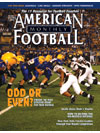AMERICAN FOOTBALL MONTHLY THE #1 RESOURCE FOR FOOTBALL COACHES
Article CategoriesAFM Magazine
|
Defending the No-Huddle Offenseby: David Purdum© More from this issue The no-huddle offense can give even the most talented defenses fits. In Georgia’s season opener against Oklahoma State, the Bulldogs struggled to get lined up correctly when the Cowboys mixed in the no-huddle on two first half scoring drives. “Early in the game, they were getting us off-balance and we weren’t getting lined up (because of the no-huddle),” Georgia coach Mark Richt said. “That was probably our biggest halftime adjustment – making sure we were lined up on time. I think there was a momentum change when they tried to pull a fast play on us in the second half and [linebacker] Brandon Miller drilled the guy in the backfield. I told our guys if we could do that once, they would stop running those hurry-up plays on us, and that’s what happened.” Getting aligned quickly and properly is just one of....The full article can only be seen by subscribers. Subscribe today!
|
|
|||||||
| HOME |
MAGAZINE |
SUBSCRIBE | ONLINE COLUMNISTS | COACHING VIDEOS |
Copyright 2025, AmericanFootballMonthly.com
All Rights Reserved





